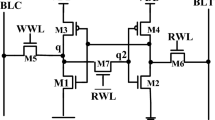Abstract
Memory block occupies most of the integrated chip area and an improvement in memory cell performance will enhance the overall system performance. Ever increasing levels of on-chip integration of static random access memory (SRAM) increases leakage and degrades cell stability. In this paper a low-power multimodal switch (LPMS) power gating structure is proposed to minimize leakage and improve data stability in SRAM cell. The proposed design provides maximum of 91% reduction in leakage power and 23.5% reduction in dynamic power over conventional methods. Read and write margins are enhanced by 4.7 and 7.5% respectively. Proposed LPMS technique offers good leakage reduction and stability even under different operating parameter variations.
Similar content being viewed by others
References
Kao, J.; Narendra, S.; Chandrakasan, A.: Sub threshold leakage modeling and reduction techniques. In: Proceedings of IEEE/ACM Conference CAD, pp. 141–148 (2002)
Taur Y.: CMOS design near the limit of scaling. IBM J. Res. Dev. 46, 213–222 (2002)
Ho, D.; Iniewski, K.; Kasnavi, S.; Ivanov, A.; Natarajan, S.: Ultra-low power 90nm 6T SRAM cell for wireless sensor network applications. In: Proceedings of the International Symposium on CAS, 4 pp (2006)
Huang, P.; Xing, Z.; Wang, T.; Wei, Q.: A brief survey on power gating design. In: Proceedings of the 10th IEEE International Conference on SSICAT, pp. 788–790 (2010)
Jiang, H.; Marek-Sadowska, M.; Nassif, S.R.: Benefits and costs of power-gating technique. In: Proceedings of the IEEE International Conference on CD: VLSI CAP, pp. 559–566 (2005)
Agarwal, K.; Austin, T.X.; Deogun,H.; Sylvester,D.; Nowka,K.: Power gating with multiple sleep modes. In: Proceedings of the 7th International Symposium on QED, pp. 633–637 (2006)
Khoshavi, N.; Ashraf, R.A.; DeMara, R.F.: Applicability of power-gating strategies for aging mitigation of CMOS logic path. In: Proceedings of the International Midewest Symposium CAS, pp. 929–932 (2014)
Lorenzo, R.; Chaudhary, S.: A novel all NMOS leakage feedback with data retention technique. In: Proceedings of the IEEE International Conference on CARES, pp. 16–18 (2013)
Takeda, S.; Miwa, S.; K. Usami, K.; Nakamura, H.: Efficient leakage power saving by sleep depth controlling for Multi-mode Power Gating. In: Proceedings of the 13th International Symposium on Quality Electronic Design (ISQED), pp. 625-632 (2012)
Pramod Kumar, M.P.; Augustine Fletcher, A.S: A novel hybrid multiple mode power gating. In: Proceedings of the International Conference on Electronic Communication System (ICECS), pp. 1–4 (2014)
Zhang Z., Kavousianos X., Chakrabarty K., Tsiatouhas Y.: Static power reduction using variation-tolerant and reconfigurable multi-mode power switches. IEEE Trans. VLSI 22, 13–16 (2014)
Mutoh S., Douseki T., Matsuya Y., Aoki T., Shigemitsu S., Yamada J.: 1-V power supply high-speed digital circuit technology with multi threshold-voltage CMOS. IEEE J. SSC 30, 847–854 (1995)
Pakbaznia, E.; Fallah, F.; Pedram, M.: Charge recycling in MTCMOS circuits: concept and analysis. In: Proceedings of the IEEE/ACM Conference on DAA, pp. 97–102 (2006)
Tada A., Notani H., Numa M.: A novel power gating scheme with charge recycling. IEICE Electron. Express 12, 281–286 (2006)
Pakbaznia, E.; Pedram, M.: Design and application of multi-modal power-gating structures. In: Proceedings of the International Symposium on QED, pp. 120–126 (2009)
Pakbaznia E., Pedram M.: Design of a tri-modal multi-threshold CMOS switch with application to data retentive power gating. IEEE Trans. VLSI Syst. 20, 380–385 (2012)
Rabaey J.M.: Digital Integrated Circuits: A Design Perspective. Prentice Hall, Upper Saddle River (1996)
Roy K., Prasad S.C.: Low-Power CMOS VLSI Circuit Design. Wiley, New Delhi (2009)
Weste N., Harris D.: CMOS VLSI Design: A Circuits and Systems Perspective. Addison Wesley, Boston (2010)
Keating M., Flynn D., Aitken R., Gibsons A., Shi K.: Low Power Methodology Manual for System on Chip Design. Springer, New York (2007)
Narendran, S.; Borkar, S.; De, V.; Antoniadisn, D.; Chandrakasan, A.: Scaling of stack effect and its application for leakage reduction. In: Proceedings of the International Symposium on LPED, pp. 195-200 (2001)
Zhao W., Cao Y.: New generation of predictive technology model for sub-45nm early design exploration. IEEE Trans. Electron. Devices 53, 2816–2823 (2006)
Liao, W.; Basile, J.M.; He, L.: Leakage power modeling and reduction with data retention. In: IEEE/ACM International Conference on CAD, pp. 714–719 (2002)
Singh H., Agarwal K., Sylvester D., Nowka K.J.: Enhanced leakage reduction techniques using intermediate strength power gating. IEEE Trans. VLSI Syst. 15, 1215–1224 (2007)
Lee D.-H., Kwak D.-K., Min K.-S.: Comparative study on leakage current of power-gated SRAMs for 65-nm, 45-nm, and 32-nm technology nodes. J. Comput. 3, 39–47 (2008)
Parke S.A., Moon J.E., Wann H.C., Ko P.K., Hu C.: Design for suppression of gate-induced drain leakage in LDD MOSFETs using a quasi-two-dimensional analytical model. IEEE Trans. Electron. Devices 39, 1694–1703 (1992)
Seevinck E., List F., Lohstroh J.: Static-noise margin analysis of MOS SRAM cells. J. Solid State Circuits 22, 748–754 (1987)
Wang, J.; Nalam, S.: Analyzing static and dynamic write margin for nanometer SRAMs. In: Proceedings of the ACM/IEEE International Symposium on LPED, pp. 129–134 (2008)
Author information
Authors and Affiliations
Corresponding author
Rights and permissions
About this article
Cite this article
Kavitha, M., Govindaraj, T. Low-Power Multimodal Switch for Leakage Reduction and Stability Improvement in SRAM Cell. Arab J Sci Eng 41, 2945–2955 (2016). https://doi.org/10.1007/s13369-016-2047-0
Received:
Accepted:
Published:
Issue Date:
DOI: https://doi.org/10.1007/s13369-016-2047-0




